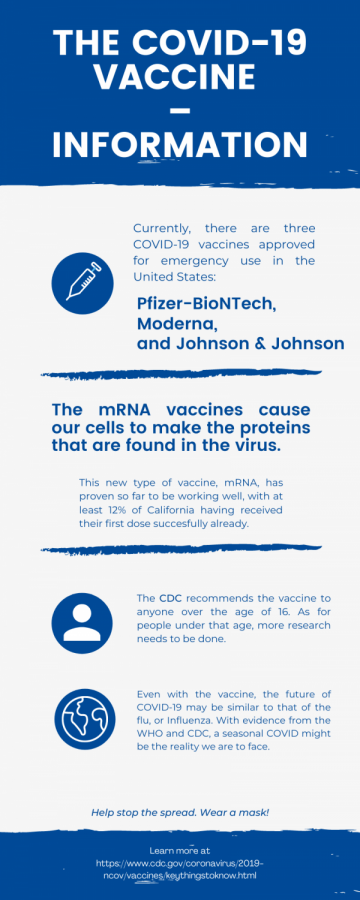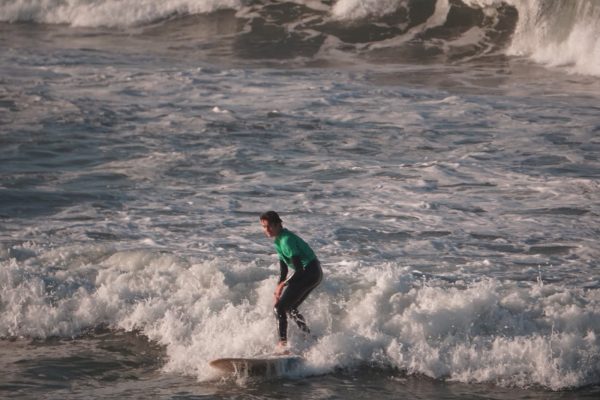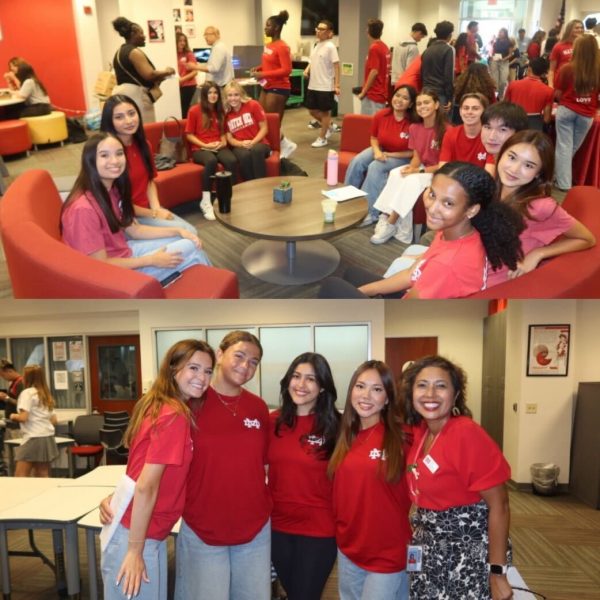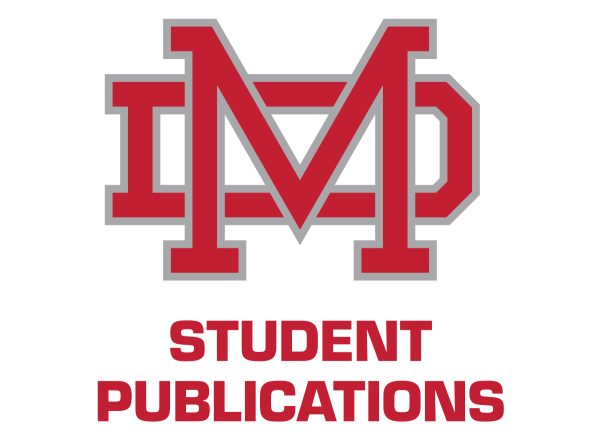The COVID-19 vaccine and the science behind it
 As the pandemic continues to overtake the lives of everyone today, the quickly-developed COVID-19 vaccine offers a much-needed light at the end of the tunnel. Though the vaccine has been highly anticipated, many are left in the dark about how the COVID-19 vaccine actually works, when they may be getting one, and if they’re safe. Currently, the three emergency authorized vaccines in the United States were made by Pfizer-BioNTech, Moderna, and Johnson & Johnson. The first two require two doses being given at separate times – Pfizer-BioNTech has to be administered 21 days apart, and Moderna must be taken 28 days apart. Uniquely, the Johnson & Johnson vaccine only requires one dose which allows for quicker vaccine distribution. The rate of vaccinations has grown as the shot continues to become more widely available.
As the pandemic continues to overtake the lives of everyone today, the quickly-developed COVID-19 vaccine offers a much-needed light at the end of the tunnel. Though the vaccine has been highly anticipated, many are left in the dark about how the COVID-19 vaccine actually works, when they may be getting one, and if they’re safe. Currently, the three emergency authorized vaccines in the United States were made by Pfizer-BioNTech, Moderna, and Johnson & Johnson. The first two require two doses being given at separate times – Pfizer-BioNTech has to be administered 21 days apart, and Moderna must be taken 28 days apart. Uniquely, the Johnson & Johnson vaccine only requires one dose which allows for quicker vaccine distribution. The rate of vaccinations has grown as the shot continues to become more widely available.
MD Director of Health and Wellness Shannon Brown said that unlike other common vaccinations, the COVID-19 vaccine utilizes a new form of antibody production which makes it especially unique, mRNA.
“It’s not a live vaccine like some [others] – measles and mumps,” Brown said. “It is similar in regards to the flu vaccine in that we are giving the body something that we want it to recognize and be able to fight off if it was to see it again… This is similar in that it is not a live vaccine, the same way a flu vaccine is not the flu vaccine obviously as for a virus called Influenza A and B, and this is obviously for the Coronavirus. So that part makes it a little different. I don’t know if people know what mRNA [is], and how detailed people are in the sense of how it’s being manufactured.”
This vaccine, using mRNA, causes our cells to make the proteins that are found in the virus. This triggers an immune response and immune memory, which allows for our body to create antibodies to fight the virus if it were to encounter it. Brown explains that the vaccine will not keep a person from contracting the virus, but it will provide help in fighting it.
“With any vaccine, it doesn’t mean you can’t get the virus… your immune system will be able to fight it off in such a good way,” Brown said. “Same thing with Influenza in some regard and that just because you get the flu shot doesn’t mean that you may not get flu symptoms. It just means the severity of them won’t be as great. The CDC [has announced] some new guidelines and what they’re saying is that for people that have had fully vaccinated (gotten both doses of vaccine) you will no longer need to quarantine. That gets people back into their jobs, school, back to life, if you will, without quarantine. I think that alone is an incentive for people to get vaccinated so that they don’t have to quarantine after an exposure.”
Even with evidence, skeptics are still hesitant as to whether or not they want to receive the vaccine themselves. Brown urges those who can get it to do so, except those who are in the age ranges that have yet to be studied.
“There’s been pretty overwhelming wildling evidence that the vaccine is well-tolerated,” Brown said. “The one area we still have opportunity to have it studied is in children. So we currently still do not have an approved vaccine for anyone under 16. So, again, I would recommend until we have an approved vaccine for students – that would be the one population under 16 – I wouldn’t recommend getting it yet because [it] just hasn’t been studied enough. I strongly encourage people to consult with their physician.”
Though there isn’t a vaccination recommended to those under the age of 16, Brown sees that there is hope on the horizon in the form of the Johnson and Johnson vaccine. However, like many others, it isn’t quite there yet.
“The Johnson and Johnson vaccine hasn’t yet gone through the FDA approval process… [It] was studied on children greater than five,” Brown said. “So I think if it gets approved, then there’s potentialdiscussion that it could be approved for children. The hope would be that potentially by April or May we will be able to start potentially giving it to students. If it isn’t approved, AstraZeneca is the next vaccine that’s currently being studied on children. We anticipate we’ll potentially have more than one option to [give] kids. And it’s one [shot]. It doesn’t have storage requirements, so it lasts a lot longer. It doesn’t have to be refrigerated. If you have to do two doses, things can get in the way for someone to come back for a second dose. This is easier… for a patient. One time is best.”
The World Health Organization continues to conduct studies on the COVID-19 vaccine to test its effectiveness. Conclusions have been made, even before the vaccines were being widely used, that the vaccination will not fully end the pandemic.
“I don’t think it’s going to [end the pandemic],” Brown said. “The vaccine is going to help us… We’ve learned so much that I think it’s two-pronged. We’ve been doing so much research on treatment modalities so that when you do get infected with COVID we know how to help better get you through it. So I think those two things in tandem are going to help end the pandemic. I think we’re still going to need to be able to treat COVID-positive people for a multitude of reasons and I think, again, the research has been done on the treatment modalities. We already know so much more about not putting patients on ventilators right away. The Remdesivir we learned so much [like how] it was originally a seven-day treatment and they got it down to five and now slowly, in many cases, a three-day treatment to have great outcomes. We’re coming up on a year of data, so the more data we have that gives more time for the scientists to be able to keep studying and see what’s the best. Schools are a perfect example. We learned how to open school safely, and because we’ve been open since September, we’ve learned so much more so that I think for fall we’re going to be even more prepared.”
Eventually, with the efforts in place, the pandemic will end and things will slowly move back to a modified normal. Brown concludes, with evidence supported by the WHO and CDC, that COVID-19 may become a seasonal illness like Influenza.
“So Influenza continues to be [seasonal], but I think we anticipate COVID to be similar in that way potentially, at least, for the next number of years,” Brown said. “We’re gonna probably need a COVID type vaccine. It’s going to be probably something that is seasonal, and the goal would be to develop it so it’s strong enough to last more than one season. But at this point, I think we should anticipate [the] COVID vaccine being a kind of a yearly or an annual expectation.”
Moving forward, assuming COVID-19 does become seasonal, we may see a different normal than previously expected. As Brown said, we may need to adapt to the changes that the virus has brought, aided by what we have learned and the vaccine we will have.
“I do think there are some [practices] that will go away [when we get] back to normal and [some] that may not change for a while like the mask usage,” Brown said. “I also think that physical distancing and some of the things around it and hygiene that we learned – those are things that we don’t want to get rid of. Hand hygiene practices are good for overall health. I hope now we have a greater awareness of that. The other thing is, I think we’re just going to be better prepared for when [another] health crisis and public health issue happens. Remote learning has not been ideal for a lot of reasons but it has been nice for kids who may be undergoing a surgery and need to be out of school for two weeks or a month. Before they wouldn’t be able to and now they’re able to. There are some parts of this that we want to take away, figuring out what were some of the positives and how we incorporate those moving forward. Never in my life as an alumni have we been able to have lunch in the Grotto, and I am super excited to see the Grotto used for kids on their flex blocks or during the middle of the day. So I think there’s some things that have been great, [and] maybe we don’t necessarily want what was normal in the past or there are some ways to make it better for the future.”
Using the information that we have gathered, both positive and negative, we will have the ability to move forward as a society. With global efforts from everyone, Brown said she believes that the COVID-19 vaccine creation has the potential to bring everything back to a more collaborative norm.
“I think it’s impressive from a scientific perspective that we were able to make things happen that quickly,” Brown said. “I will say that from an FDA perspective, it went through the same process that every vaccine does. The only thing I think that was so impressive was the degree in which the researchers were able to develop the vaccine. It’s kind of like using a previous cookie-cutter that they were able to do it. We’ve gotten so good at studying viruses that we can use that evidence in the process and I also think it was like all hands on deck so everyone was working really hard globally. So I don’t think there’s been a case where we’ve been so successful as a global nation to pull everyone together to work on something so that should be seen as a positive thing.”
Your donation will support the Student Publications Department at Mater Dei High School. Your contribution will allow us to keep our equipment up to date and cover our annual website hosting costs.








![SETTING THE STANDARD: Mater Dei High School and Playfly Sports announced its historic media partnership in the spring of 2025. As Mater Dei Athletics continues to achieve new heights, Playfly will introduce new partnerships and sponsors for these programs. With the added revenue and resources, Mater Dei can improve the high school experience for all students, while engaging the community in a showcase of Monarch pride. “[This partnership is designed] to increase the experience that our athletes and our non-student athletes have with the [athletic] programs,” Melvin said. “School spirit, engagement, and pride are all things we [keep in mind].” Photo taken by Kenzington Ragge.](https://thescarletscroll.com/wp-content/uploads/2025/09/IMG_0237-600x450.jpeg)